
Electricity Pylon Frequently Asked Questions
All images are copyright of their respective owners and may not be reproduced elsewhere in any way
This FAQ covers questions about pylons, high voltage power lines, and my hobby of collecting images of pylons.
If you would like to email me a different question, please click here.
Terminology: I have used the term pylon as this is most commonly understood by readers in the UK. They are also known as towers, or steel lattice towers. I have also used the terms cable and wire interchangeably; people refer to cables but perhaps wire (or conductor) would be more correct. I also refer to lines, as in powerlines.
-
About pylons
- Do pylons or power lines cause cancer?
- How do I find out who owns or is responsible for a specific pylon?
- Who designs pylons?
- What designs / structures / shapes are there?
- Is there one specific pylon in the UK that's seen as the top dog?
Things to do with pylons
- Can I make a model of a pylon?
- Are there any experiments I can do with pylons?
- Are there any pylon appreciation societies in this country?
- Are there people who 'spot' pylons, e.g. take their number?
About Flash's interest in pylons
- Do you see pylons as a thing of beauty, or an eyesore?
- Why do you like pylons - how did you first 'get into' them?
- How far have you travelled to see pylons?
- How can I contribute to your site?
Do pylons or power lines cause cancer?
Firstly, remember that the pylon itself is an inert metal structure, it is the powerlines themselves that you should consider. So don't just look at the proximity of pylons, look at the proximity of powerlines in general. Powerlines can go underground but only seem to get noticed when they are overhead; how many people look up the location of underground lines, yet are concerned by seeing a pylon near their house? In any case, if you wish to have electricity in your house, you will need to tolerate the transmission that provides it!
In any case, there appears to be no proof that there is a link between power lines and cancer - however I am not a scientist and I encourage you to make your own mind up.
This is a topic which is often in the news and it seems that as soon as a piece of research appears to show a link, another piece of research disproves this. In addition, as Cancer Research state "we have no idea how pylons (or rather the electrical cables they carry) could cause cancer. There is a school of thought that says that the electric field or magnetic field associated with the current-carrying wires might cause problems in some way. Also, dust particles become ionised and it is thought that if these ionised particles are ingested that may somehow cause cancer. However, so far there seems to be no proof either way."
For example if you search BBC News online for articles about pylons and cancer a variety of headlines are found, which are either inconclusive or which contradict an earlier story. One story says "The UK Government's radiation watchdog admits there is a 'weak association' between electromagnetic fields and leukaemia" and a later story says "UK research casts further doubt on claims of a link between overhead power lines and childhood leukaemia". This story, from March 2004, sums up that "one of the largest investigations to focus on power line radiation, the UK Childhood Cancer Study, found no evidence of increased risk."
There are various websites for and against, have a look and see what you think. Personally I do not believe that powerlines can or will cause cancer, but I am not a scientist and can only go on the reports I have read.
Further reading:
-
BBC News stories on the subject
- National Grid explanation of EMF
- Cancer Research UK - who begin
by saying "There is no real proof that electromagnetic fields do cause cancer."
- Committee on Medical Aspects of Radiation in the Environment
FAQ - mainly relates to nuclear power
- National Grid's website about Electromagnetic Fields
How do I find out who owns or is responsible for a specific pylon?
For high voltage pylons, the procedure is quite straightforward. You should make a note of its exact location and preferably its number too. The number will be on a small placard on one side of the pylon, about five metres from the ground. For this reason it is worth using binoculars even if you can get near to the pylon. You will also need to ensure you are on the correct side to view the number (they don't make it easy!) The number will be a few letters and digits, for example the one shown below is YYJ18. I have indicated where the number is shown:
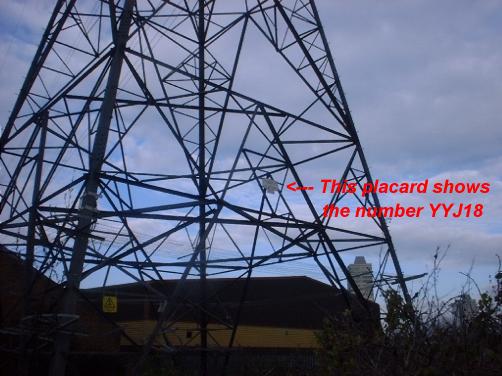
Finally, you should also note the company name on the placard. Then you should contact the appropriate company to find out whatever you need to know about the pylon. However, often an old name is seen such as CEGB - now National Grid Transco. Many pylons will belong to National Grid and they are a good port of call, however they will only know about "their" pylons. Their contact details are on this webpage.
It is also possible that the landowner might know to whom the pylon belongs, as he will usually have an agreement with the transmission company to recompense him for the use of the land.
I am told that as the identification placards are on the pylon for reference in safety-related documentation, they are not always in the same place or easy to spot. For example sometimes they are right at the top, so they can be read by aircraft.
Who designs pylons?
Pylons are designed by the contractor, who then tests and builds them. In the UK, architect Sir Reginald Blomfield chose the pylon design used by the CEGB, in 1928. It has developed since then and you can read more about pylon designs in the illustrated guide to pylon/tower model types.
These days, pylons are rarely built, and although the National Grid website reports that various new designs have been commissioned (some are graceful metal poles) and that an appropriate design would be used where pylons are required in the future, there have recently been some continental style pylons erected in Burton-on-Trent by the Petit Jean company, and some more usual pylons built near Middlesborough. The National Grid uses some standard designs (see the question on pylon designs).
What designs / structures / shapes are there?
[N.B. Many of the designs mentioned are shown at the end of the descriptions.]
In the UK we have three common designs, called the L2, L6 and L12. The L2 is designed for 275kV lines, the L6 for 400kV, and the L12 for either 275kV or 400kV lines. The L6 is slightly taller and broader, with a slightly stockier look. There are examples of these in this pdf on the National Grid website.
However, there are many more models. If you would like to learn more, see this illustrated guide to different pylon/tower model types. Geeks only!
In general, there are "suspension" pylons where the insulators hang down and these are the most common. There are also deviation pylons, where the lines turn a corner (sometimes only slight), and these are called "angle pylons" on my site. These are "tension" pylons where the insulators go horizontally out from the arms of the pylon.
Sometimes a pylon that is over-spec'd is used for a lower voltage circuit. The size of the string of insulators provides a clue as to the voltage in the lines, but only enough to hazard a guess rather than to be sure.
Other designs include terminal pylons, where the lines end and go into a substation or go underground, and a pylon used for crossing rivers. These seem to be the same across the UK.
For the supply of lower voltages, e.g. to a small number of houses in the countryside, wooden or metal poles are often used in place of pylons. The poles go across the fields, and near the houses a pole-mounted transformer often takes the place of a substation.
In other countries, many different designs are used, sometimes to withstand ice storms or differing weather conditions. In Scandinavia, guyed pylons are sometimes seen, and in Japan they tend to have many more arms than the UK standard of three per side. If you look at my photo pages you can see a wide range of designs around the world.
There is also one very special design of pylon called a Transposition Tower, which unfortunately we do not require in the UK. Its purpose is very specific. Each pylon carries lines in a multiple of three - usually 3 or 6 lines per pylon. In each set of three, one wire will be for each phase. Ideally, the capacitance of each line should be the same. However, the different heights at which each line is carried means there is a small difference in length between them. For short distances, the difference is tiny and can be discounted. However in areas where the lines run for hundreds of miles, such as across Africa or Continental Europe, these differences between the sets of wires can be enough to cause problems. So a transposition tower is used to swap the electricity from one line onto another, in order that over the entire line, the capacitance of each line will be more-or-less the same.
Ian McAulay of Envision adds: Early transmission practice in the UK did use transposition towers, but they were found to be unnecessary and the transpositions were generally eliminated when reconductoring lines that included them. Where they remain, transposition towers are just used as ordinary tension towers, but the extended top and bottom crossarms are characteristic. Here's an example of model PL1b (below).
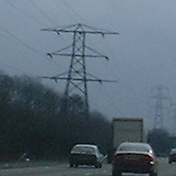 Single-circuit transpositions are left in place as they are engineered
differently. If you imagine a long
line of towers with one arm out to one side and two out to the other,
then the conductors are carried in a delta formation. To do the
transposition, you want to rotate the delta through 120 deg. You
can't do that in one span, otherwise they will all touch in the middle.
Instead, you put one tower in the other way round to all the others and
you can achieve the transposition in two spans that way. It looks very
odd but neatly avoids the need for a special tower.
Single-circuit transpositions are left in place as they are engineered
differently. If you imagine a long
line of towers with one arm out to one side and two out to the other,
then the conductors are carried in a delta formation. To do the
transposition, you want to rotate the delta through 120 deg. You
can't do that in one span, otherwise they will all touch in the middle.
Instead, you put one tower in the other way round to all the others and
you can achieve the transposition in two spans that way. It looks very
odd but neatly avoids the need for a special tower.Thanks Ian!
N.B. There are very few "standard" pylons on my site - I find the unusual ones more interesting!
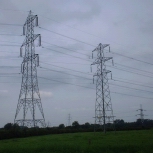 I believe this to be an L6 on the left. On the right is a pylon carrying 132kV. Thanks to Michael Randall |
 A river-crossing pylon, over the Avon near Bristol |
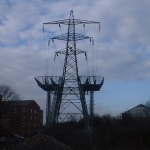 A terminal pylon, at Stratford in East London. |
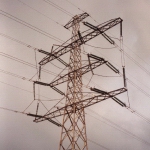 A transposition tower in Beilen, Netherlands. Thanks to Arnie Berkers |
 Typical deviation tower by the M5 near Bristol |
 Poles carrying electricity near Cressing, Essex. |
Is there one specific pylon in this country that's seen as the top dog or one which you particularly like?
The Pink Pylon is probably the best known, particularly because of its appearance in the film Among Giants. However it's a pretty ordinary L2 design (other than being painted). There is a website about the Pink Pylon, here. Sadly the line was decommissioned and the pylon taken down in November 2003.
So the title probably goes to the tallest pylons in the UK, which are a pair of pylons which span the Thames at Thurrock, next to the Queen Elizabeth II bridge. At 630ft high they are taller than London's Post Office Tower - this makes them two of the tallest structures in the country.
The pair can be seen in various places on the photos pages.
It's worth also mentioning the pair crossing the Severn Estuary - the greatest span in the UK.
My personal favourites however are on the edge of Cressing village in Essex. They are next to Braintree substation, and are easily viewed from a nearby public footpath as well as being visible from the A120. They are quite unusual in design and route cables on the left circuit under the right circuit into a substation. Here they are:
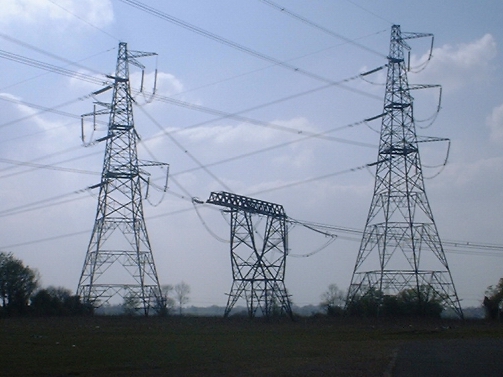
Can I make a model of a pylon?
Absolutely! Hornby make a kit to go with their 00 gauge trainsets, but the pylons stand alone and can be made by anyone. The kit can be bought for around £10.30 and contains the parts for three pylons each 207mm high. You need some model glue to complete them, and as they can be quite fiddly I wouldn't recommend them for children. If you get some nylon thread, you can make "cables" too.
They are easily found online (search for Hornby R530) and look like this:


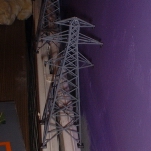
I have also seen photos of a pylon made in K'NEX.
If anyone makes a model of a pylon another way, I'd love to hear about it!
Are there any experiments I can do with pylons?
There is one experiment you can do safely, which is to use the electric field around the cables to make a fluorescent tube glow. It feels a bit like holding a lightsaber!
You need to take a fluorescent tube, like you'd use in a kitchen, and it must be the kind that connects at both ends (not the kind that loops back on itself). On a dark night, go and stand under high-voltage cables and grip the tube near the bottom, holding it vertical. It should glow! The more different cables you can stand under the better it works, so a short distance from a substation where there are lots of different lines radiating out will give a great effect. It feels really eerie to be holding something which is not connected but spontaneously starts glowing!
Why does it work? Well, you may remember electric fields from physics lessons - if not, have a read of this page - which explains it better than I could!
Regarding high-voltage cables, there will be a small but detectable electric field around the wires. The field is strongest where there are a number of different lines nearby, for example two or three sets of pylons going in different directions, which is why I suggest near a substation. When you hold the fluorescent tube vertically, the tube cuts through the field lines. The electric difference between the top and bottom of the tube causes a small flow of electricity which causes the tube to fluoresce.
You can check this by moving the tube to be horizontal. As you move it lower and lower the glow decreases. As you move it vertical again, the glow increases.
|
Here is a picture of my father holding a tube under cables near
a large substation in Taunton, Somerset. |
The principle was used in an art exhibition, Field, consisting of
many tubes under some low profile pylons and power lines near Bristol.
My photos of Field are here. |
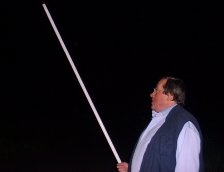 |
 |
You could also try experiments involving radio reception around high-voltage lines. The IRA conducted experiments to try to destroy pylons - but I can't recommend those!
Are there any pylon appreciation societies in this country?
Yes! The Pylon Appreciation Society is an offshoot of this website and provides member benefits such as a "Spotter's Guide" and the facility to answer all your questions in detail.
There is also a club which caters for insulator collectors (from both pylons and telegraph poles) and those interested in pylons and poles are welcome to join. It's the British Insulator Collectors Club. Its website is at http://www.insulators.org.uk/ although it hasn't been updated for a few years. If you want to find out more about it, write to BICC, P.O. Box 3275, Wolverhampton, Staffordshire, Great Britain WV4 6XU. An A4 or A5 sized SAE is appreciated, but not essential.
Are there people who 'spot' pylons, i.e. take their number?
Not that I'm aware - and actually it's very hard to see the number on a pylon. You have to be right next to it or using binoculars, and looking at the correct of the four sides.
The Pylon of the Month website which Harvey Brant used to run (it hasn't been updated in ages) does quote the number of the pylon, but I prefer to focus on structure rather than number. Besides, it looks like Harvey's site was a spoof, to embarrass his trainspotter friends. He seems rather proud of the awards he has won in the "Worst Website" categories!
Do you see pylons as things of beauty or as an eyesore?
I don't think they are wonderfully attractive and that plonking a pylon down anywhere would enhance the landscape without question! But I don't think they are an eyesore, rather an item of curiosity.
They remind me of people in form - they have a head and arms and legs - and in that way are something that is vaguely familiar to us. Remember the TV advert from the sale of National Power and PowerGen, when pylons strutted across the land, putting problems right?
I also like them up close - the triangle shapes made by the struts - and the size of the insulators. Each insulator weighs several kilos, and there are several insulators in each string, so as I get up close the scale of things makes me stop to think.
Why do you like pylons - when did you first 'get into' them?
I was always interested in the shape. When I started my personal website in 1999 I wanted to write about my hobbies and interests and thought I would write something about pylons. Then as I took more of an interest (for example, taking photos for the website) I noticed more about them; how there are different designs and shapes, e.g. to turn a corner, and also approaching substations where more custom-made designs can be seen. I started to think more about the purpose of each design.
Anyway, this caught my imagination, that pylons have specific purpose. That it's not as simple as merely carting power from A to B by sticking down uniform metal blobs which achieve this.
I've written a profile of myself and my interest in pylons for the British Insulator Collectors' Club magazine, the B.I.C.C. Telegraph. If you're really interested, you can read this article here.
How far have you travelled photographing pylons - do you go on specific trips to see pylons, or do you simply photograph pylons wherever you travel?
Largely, I do just take my camera when I go away (and urge friends and colleagues to take theirs when they go abroad) - although I have made small excursions of a few miles out of my way to see specific pylons or for a particular purpose.
I've also travelled to sites where pylons are being dismantled.
So I do sometimes go out of my way but I couldn't afford to travel the globe on a pylon-spotting mission!
How can I contribute to your site?
Easy, simply send me a picture of a pylon! I've got lots from the UK so I'm looking for unusual designs, or if you go abroad photos of any pylons from other countries are welcome.
Simply fill out this form and I'll tell you where to email the picture, or let me have a URL. Or if you only have a hard copy, state that on the form and I'll give you my postal address, scan the image and send it back to you.
All contributors are named on the contributors page - unless they don't want to be. However you must own the photo because I don't want any copyright issues. If you don't own the image I'm probably interested in seeing it, but I can't use it on the website. I never publish an image without permission so I rely on goodwill from people spotting pylons all over the world!
If you have photos from any countries I don't already have listed they are the most welcome of all - I would love to have a photo of a pylon in every single country!
All images are copyright of their respective owners and may not be reproduced elsewhere in any way
This page last updated: 01 September 2022

If you have a comment, please leave it in the guestbook. To contact Flash directly, complete this form. Like this site? Buy me a drink!
This site moved from a fixed width to the current layout in 2009. Some older content such as photo sets may still have a fixed width. However if you notice any pages which are actually broken, please be kind enough to let me know via this form.
© Flash Wilson 1999-2010. I charge a fee for use of my photos.
